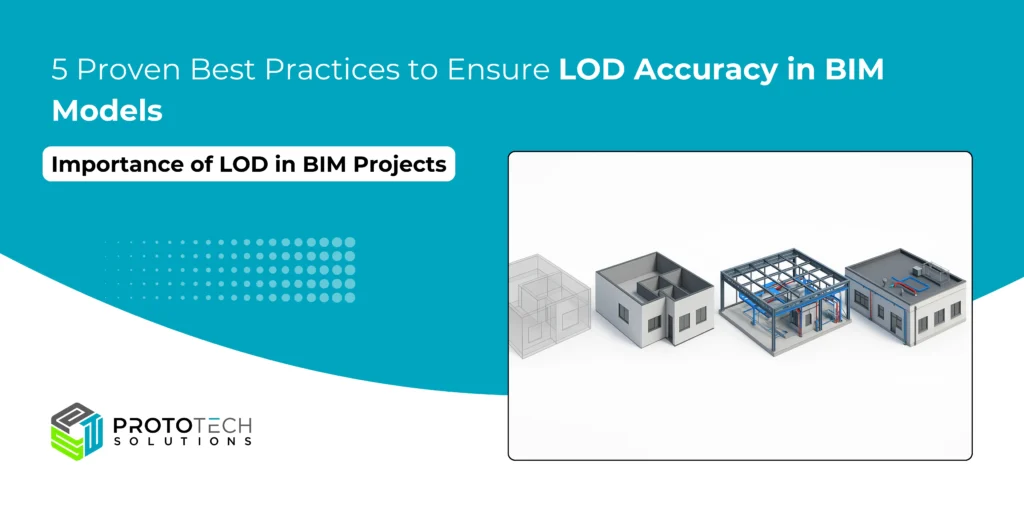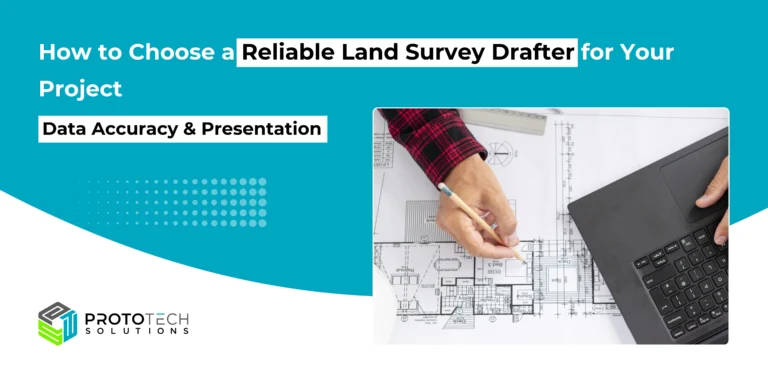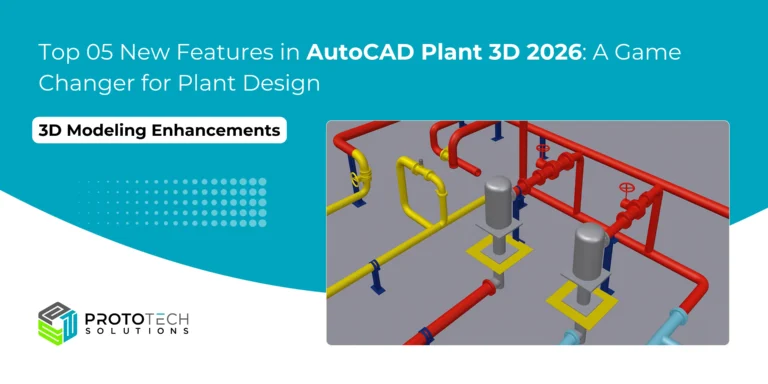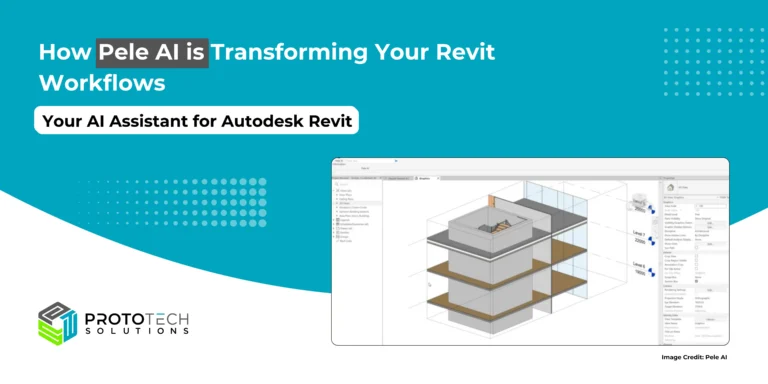5 Proven Best Practices to Ensure LOD Accuracy in BIM Models

Building Information Modeling (BIM) has become a cornerstone in modern architecture, engineering, and construction (AEC) workflows. One of its most crucial elements is the Levels of Development (LOD), which determines the clarity and reliability of every BIM model. Ensuring LOD accuracy is vital for streamlined communication, effective collaboration, and successful project outcomes.
In this blog post, we will explore what LOD means in BIM, the different types of LOD levels, why it matters, and five proven best practices to ensure your BIM models maintain the highest accuracy possible.
What is the Level of Development (LOD) in BIM?
LOD in BIM refers to the degree of completeness, detail, and accuracy represented by each element within a digital model. It defines how much information about a component, such as geometry, specifications, and fabrication details, is included at every stage of a project’s lifecycle.
There’s often confusion between Level of Detail (the granularity of graphical elements) and Level of Development (the reliability and usability of information for specific purposes). Both terms are critical, but in BIM, LOD usually combines these ideas to guide project teams on meeting modeling and information standards at each phase.
LOD ensures that stakeholders, from architects and engineers to contractors and facility managers, work with models that are aligned with the project’s current stage.
For example:
- At an early design phase, the BIM model may contain only conceptual shapes and spatial layouts.
- At later stages, the model includes highly accurate measurements, construction details, and material specifications.
Types of LOD Stages in Architectural BIM Modeling
The BIM industry applies standardized LOD specifications, typically set by organizations like the American Institute of Architects (AIA):
| LOD Level | Description | Typical Use |
| LOD 100 | Conceptual massing: only general shapes and system representations | Feasibility & conceptual design |
| LOD 200 | Approximate geometry; basic systems with estimated dimensions | Schematic design & early analysis |
| LOD 300 | Accurate geometry with specific placements and details | Design development |
| LOD 350 | Includes systems, interfaces, and more refined element detail | Coordination & shop drawings |
| LOD 400 | Fabrication-level assemblies and installation details | Construction and prefabrication |
| LOD 500 | As-built geometry and actual installed conditions | Facility management, operations |
Each step up the LOD ladder represents a higher degree of confidence and usefulness of the modeled information, ensuring the BIM model supports the intended project phase and decision-making processes.
Importance of LOD in BIM Projects
Getting LOD right isn’t just a technical requirement—it impacts every facet of a BIM project:
- Clarity for All Stakeholders: Standardized LOD ensures everyone—from architects to contractors to facility managers—understands what detail and information can be relied upon at a given project stage.
- Reduced Errors & Rework: Accurate, stage-appropriate detail minimizes costly misunderstandings, clashes, and redesigns, reducing overall project risk.
- Optimized Project Resources: Right-sizing the detail at each phase prevents over-modeling and unnecessary resource allocation.
- Confidence in Fabrication & Operations: Higher LOD levels provide the information needed for off-site fabrication, installation, and ongoing building management.
Best Practices to Ensure LOD Accuracy in BIM Models
To maximize the value of BIM, teams must ensure rigorous LOD accuracy. Here are five proven best practices:
1. Define LOD Requirements Early and Document Them
- Establish clear LOD requirements in your BIM Execution Plan (BEP) before modeling begins. Specify the required LOD for each project phase and discipline, tailored to stakeholder needs and the project’s complexities.
- Use standardized LOD definitions as per AIA, BIMForum, or national standards to prevent subjective interpretations.
- Consistently document these requirements so every participant understands the level of reliability for each model element, reducing ambiguities across the supply chain.
2. Implement Robust QA/QC and Model Validation
- Develop strict Quality Assurance/Quality Control (QA/QC) processes at every project stage to check that model elements meet the required LOD.
- Use BIM software tools for automated clash detection and deviation analysis, helping to quickly identify geometrical inaccuracies and missing information.
- Conduct frequent manual and automated model reviews, referencing checklists aligned with LOD standards before major project milestones.
3. Facilitate Continuous Collaboration and Coordination
- Promote regular communication between design, engineering, and construction teams so model modifications address real design intent and meet LOD targets.
- Use collaborative platforms and shared models to ensure everyone is referencing the most accurate and up-to-date model, minimizing the risk of rework due to LOD discrepancies.
4. Standardize Model Element Naming and Data Structures
- Adopt standardized naming conventions and data organization across project files to avoid data inconsistencies and enhance model transparency.
- Structure data so that non-graphical information (e.g., materials, manufacturer specs) aligns with each LOD level’s expectations.
- Use templates and libraries validated to meet your LOD guidelines, preventing the use of under-detailed or over-detailed model elements.
5. Verify Models Against As-Built Conditions
- As the project progresses, routinely compare the BIM model to as-built onsite conditions through field surveys, laser scans, or drones to ensure real-world accuracy.
- Integrate this as-built data into the BIM model, particularly for achieving LOD 500, a process critical for precise facility management and maintenance.
Conclusion
Ready to elevate your next BIM project? Start by reviewing your LOD guidelines and quality protocols, then put these five best practices into action for more accurate, reliable, and high-performing BIM models.
LOD accuracy is foundational for successful BIM-driven projects. The best outcomes stem from early planning, clear documentation, standardized practices, rigorous reviews, and continuous alignment with real-world conditions. By following these best practices:
- You reduce costly errors and increase project efficiency.
- You enhance stakeholder trust and collaboration.
- You pave the way for advanced uses like prefabrication, sustainable design, and lifecycle management.
If you’re seeking expert support on LOD management or need BIM modeling services that guarantee accuracy, reach out to our team of BIM specialists today. Let’s transform your next project with precision and efficiency!






